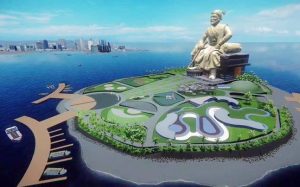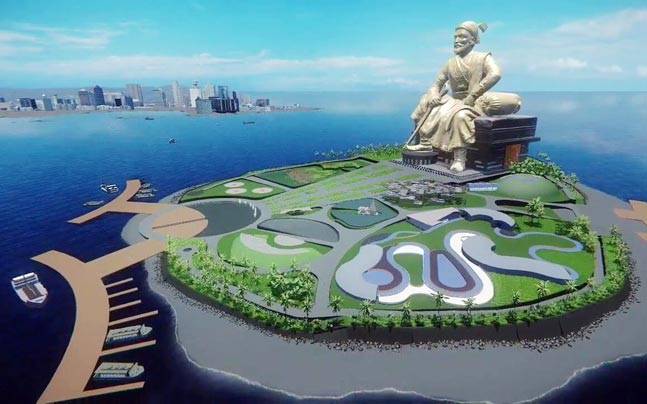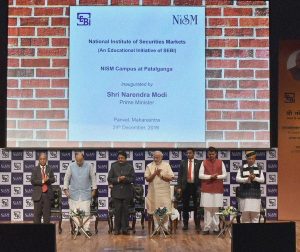Prime Minister Narendra Modi was on a-day-long visit to Maharashtra on December 24, 2016, where he laid the foundation stone of ‘Shiv Smarak’, the grand memorial of Maratha warrior king Chhatrapati Shivaji Maharaj in the Arabian Sea off Mumbai coast.
- Modi took a hovercraft from Girgaum Chowpatty to the island and performed Bhoomi poojan and Jal poojan for the ambitious sea memorial dedicated to the great warrior in the Arabian Sea, around 1.5 km from Mumbai shoreline at Marine Drive.
- Mr Modi immersed the soil and water collected from various forts and rivers across Maharashtra to mark the bhoomipujan of the memorial.
- Along with PM Modi, Maharashtra Chief Minister Devendra Fadnavis, BJP ally Shiv Sena’s chief Uddhav Thackeray and Governor Vidyasagar Rao were also present on board the hovercraft.
- The state government has secured 12 major permissions from the Centre including those from the Environment Ministry, Defence Ministry, Indian Navy, Indian Coast Guard and other.
- The memorial project has been facing stiff opposition from fishermen and environmentalists, who have alleged that it would affect marine life and ecology of the Arabian Sea. The fishermen community leaders, however, decided not to protest further after meeting Maharashtra Chief Minister Devendra Fadnavis, who assured them that their concerns will be addressed.
- The PM also inspected a float depicting Shivaji Maharaj’s coronation.
Features of the Shivaji Memorial
The Shivaji memorial is proposed to be build on around 15-hectare Island with as high as 192 metres tall statue of the iconic Maratha king.
- The statue will be more than twice the height of the Statue of Liberty once completed and is expected to be the world’s tallest statue.
- The total outlay of the project is Rs. 3,600 Crore.The project is expected to be completed by 2019.
About Chhatrapati Shivaji Maharaj
Shivaji Bhonsle, also known as Chhatrapati Shivaji Maharaj, was an Indian warrior king and a member of the Bhonsle Maratha clan. In 1674, he was formally crowned as the Chhatrapati (Monarch) of his realm at Raigad.
- Shivaji was born in the hill-fort of Shivneri, near the city of Junnar in Pune district on 6 April 1627 or 19 Feb. 1630. The Government of Maharashtra accepts 19 February 1630 as his birthdate; other suggested dates include 6 April 1627 or other dates near this day.
- As per legend, his mother named him Shivaji in honour of the goddess Shivai, to whom she had prayed for a healthy child.
- Shivaji demonstrated great skill in creating his military organisation, which lasted till the demise of the Maratha empire. He also built a powerful navy. He built new forts like Sindhudurg and strengthened old ones like Vijaydurg on the west coast.
- Shivaji’s statues and monuments are found almost in every town and city in Maharashtra as well as in different places across India including Goa, Bangalore, Vadodara, Surat, Indore, Agra, Arunachal Pradesh, and Delhi.
PM Laid the foundation stone of Mumbai Metro Projects & Pune Metro Rail Project
The Prime Minister also laid the foundation stones for two Mumbai Metro projects.
- The Elevated Railway Corridors Project and
- The Mumbai Trans Harbour Link project (MTHL)
He also addressed a public rally at the Bandra Kurla Complex in Mumbai at Metropolitan Region Development Authority (MMRDA) ground
Later, the PM headed to Pune, where he laid the foundation stone of the Pune Metro Rail project at the Agriculture College ground. He was accompanied by the NCP leader Sharad Pawar.
Prime Minister Narendra Modi inaugurates National Institute of Securities Markets (NISM) in Mumbai
During his visit to Mumbai, PM Modi laid the foundation stone of a new campus of SEBI’s National Institute of Securities Markets (NISM) at Patalganga in Mumbai.
- Prime Minister Narendra Modi arrived in Mumbai by an IAF aircraft. On his arrival at the Chhatrapati Shivaji Maharaj International Airport, Mumbai, he was received by
 Maharashtra Governor C. Vidyasagar Rao, Chief Minister Devendra Fadnavis and other senior officials.
Maharashtra Governor C. Vidyasagar Rao, Chief Minister Devendra Fadnavis and other senior officials. - From the airport, Modi proceeded to Raigad to inaugurate the new campus of the SEBI’s National Institute of Securities Markets which is situated on the Mumbai-Pune Expressway, around 70 km from downtown Mumbai.
- The new NISM campus, spread over 70 acres at Patalganga, has a potential of accommodating 5,000 students and Securities and Exchange Board of India has invested more than Rs 400 crore in the institute.
About NISM
NISM is an educational initiative of capital markets regulator SEBI. NISM presently operates from its campus in Vashi, Navi Mumbai, but the existing infrastructure is inadequate to meet its growing requirements.
- The institute carries out a wide range of capacity building activities at various levels aimed at enhancing the quality standards and increase the participation in the securities markets.
About SEBI
- The Securities and Exchange Board of India (SEBI) is the regulator for the securities market in India. It got statutory powers on 12 April 1992 through the SEBI Act, 1992.
- Founded: 1992
- Headquarter: Mumbai, Maharashtra
- Chairman: U.K. Sinha



 Maharashtra Governor C. Vidyasagar Rao, Chief Minister Devendra Fadnavis and other senior officials.
Maharashtra Governor C. Vidyasagar Rao, Chief Minister Devendra Fadnavis and other senior officials.

